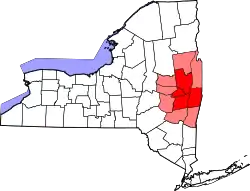Gloversville, New York
Gloversville is a city in the Mohawk Valley region of Upstate New York, and the most populous city in Fulton County. Gloversville was once the hub of the United States' glovemaking industry, with over two hundred manufacturers in Gloversville and the adjacent city of Johnstown.[6] In 2010, Gloversville had a population of 15,665.[7] In 2019, the U.S. Census Bureau's estimates program calculated that the city's population was 14,747.[8]
Gloversville | |
|---|---|
| City of Gloversville[1] | |
 Chamber of Commerce Building | |
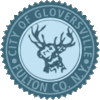 Seal | |
 Gloversville Location in the U.S. state of New York | |
| Coordinates: 43°3′N 74°21′W | |
| Country | United States |
| State | New York |
| County | Fulton |
| Incorporated (village)[2] | 1853 |
| Incorporated (city)[2] | March 19, 1890 |
| Government | |
| • Type | Mayor-Council |
| • Mayor | Vincent DeSantis (D) |
| • Common Council | Members' List[3]
|
| Area | |
| • Total | 5.05 sq mi (13.09 km2) |
| • Land | 5.05 sq mi (13.07 km2) |
| • Water | 0.01 sq mi (0.02 km2) |
| Elevation | 820 ft (250 m) |
| Population (2010) | |
| • Total | 15,665 |
| • Estimate (2019)[5] | 14,747 |
| • Density | 2,922.51/sq mi (1,128.37/km2) |
| Time zone | UTC-5 (Eastern (EST)) |
| • Summer (DST) | UTC-4 (EDT) |
| ZIP code | 12078 |
| Area code(s) | 518 Exchanges: 725,773,775 |
| FIPS code | 36-29443 |
| GNIS feature ID | 0951265 |
| Website | www |
History
Settlers came to the Gloversville area as early as 1752.[9]
The region, historically known as "Kingsborough", was acquired by Sir William Johnson, 1st Baronet, who established tremendous influence with the Native Americans of the area, which translated into control of the Mohawk Valley region. It was due to Johnson that the Six Nations Iroquois Confederacy remained allied with English during the French and Indian War. In reward, Johnson was granted the Kingsborough Tract, a large parcel of land which was settled by Scottish Highlanders. The Highlanders were so loyal to Johnson that when he died in 1774, they followed his son to Canada.[10]
In 1752, Arent Stevens purchased land in the area. Puritans from New England settled there at the end of the 18th century, utilizing the houses and cleared land that had been left behind when the Highlanders emigrated.[10] By 1803, according to Elisha Yale, the population of Kingsborough consisted of "233 families and about 1,400 souls. Of the families, 191 are of English descent, twenty three Scotch, fourteen Dutch and five Irish."[10]
In 1852 Gloversville had a population of 1,318 living on 525 acres in 250 smal wood frame houses centered on the "Four Corners" formed by the intersection of Main and Fulton Streets.[9] The proximity of hemlock forests to supply bark for tanning made the community a center of leather production early in its history: there were already 40 small glove and mitten factories there by 1852.[9] The city would become the center of the American glovemaking industry for many years. From 1890–1950, 90% of all gloves sold in the United States were made in Gloversville.[11]
Upon the establishment of a United States post office in 1828, "Gloversville" became the official name of the community. Prior to that Gloversville had been known as "Stump City" because of the large number of trees that had been cut down.[12] In 1853, Gloversville incorporated as a village,[9] and then in 1890 as a city.[2] The city grew rapidly, and the population swelled from 4,000 in 1877 to 13,864 in 1890. Glove-making operations changed from being home-based to being factory-based
Glove-making operations had gradually changed from being home-based to being factory-based, and large tanneries and glove shops employed nearly 80% of the residents of Gloversville area. Home workers sewed the gloves from leather that had been cut in factories. Related businesses, such as box makers, sewing machine repairmen, and thread dealers opened to serve the industry.
Until 1936, Gloversville had a very active electric interurban line, the Fonda, Johnstown and Gloversville Railroad. It ran from Gloversville, through Johnstown, along the Mohawk River to Amsterdam, then to Scotia, then across the Mohawk River, and into downtown Schenectady to the New York Central station. In 1932, in a bold move during the Great Depression it acquired unique bullet cars in an attempt to revive the economy. Freight operation continued through this era.[13] Gloversville also became the main headquarters for the Schine movie industry in the mid-20th century.[14]
Following the Great Depression, the decline of the glove industry left the city financially depressed with many downtown storefronts abandoned and store windows covered with plywood. Many houses were abandoned when people moved out of town to find jobs elsewhere. The city's population peaked at 23,634 in 1950 and had since fallen to 15,665 people in 2010.[15] In 2018, redevelopment plans of downtown Gloversville were revealed.[16] In 2019, Mayor Vincent DeSantis (D) proposed economic revitalization plans.[17] On June 5, 2020 the Regan Development Corporation, based in Ardsley, New York, proposed plans to develop a new commercial space and apartment complex for the city.[18] The city, long with the Fulton County Center for Regional Growth, also began expanding digital marketing to attract new residents and businesses from throughout New York State in efforts to diversify.[19]
Geography
According to the United States Census Bureau, the city has a total area of 5.1 square miles (13.3 km2), of which 0.0077 square miles (0.02 km2), or 0.17%, is water.[7] New York State Route 29A (Fulton Street) is an east-west road through the city. New York State Route 30A is a north-south highway along the east edge of the city, leading south 4 miles (6 km) into Johnstown and northeast 5 miles (8 km) to Mayfield at the southwest end of Great Sacandaga Lake. Another north-south highway, New York State Route 309 (Bleecker Street), has its southern terminus at NY-29A in the center of Gloversville.
Cayadutta Creek, a tributary of the Mohawk River, flows southward through the city.
The city sits in the foothills of the Adirondack Mountains and therefore is within a climatic transition zone. Gloversville experiences the warmer summer temperatures common throughout the Capital Region, Hudson Valley, and Mohawk Valley while experiencing generally more copious precipitation throughout the year than the Capital Region. This manifests in commonplace rolling thunderstorms throughout the summer months and snowfall amounts more akin to the lake-pocked higher elevations of the Adirondacks in the winter months.
| Climate data for Gloversville, New York (12078) | |||||||||||||
|---|---|---|---|---|---|---|---|---|---|---|---|---|---|
| Month | Jan | Feb | Mar | Apr | May | Jun | Jul | Aug | Sep | Oct | Nov | Dec | Year |
| Record high °F (°C) | 68 (20) |
62 (17) |
83 (28) |
90 (32) |
90 (32) |
96 (36) |
98 (37) |
96 (36) |
99 (37) |
87 (31) |
77 (25) |
66 (19) |
99 (37) |
| Average high °F (°C) | 28 (−2) |
32 (0) |
41 (5) |
55 (13) |
68 (20) |
76 (24) |
80 (27) |
79 (26) |
71 (22) |
58 (14) |
46 (8) |
34 (1) |
56 (13) |
| Average low °F (°C) | 10 (−12) |
11 (−12) |
21 (−6) |
33 (1) |
44 (7) |
54 (12) |
58 (14) |
57 (14) |
48 (9) |
36 (2) |
28 (−2) |
17 (−8) |
35 (2) |
| Record low °F (°C) | −29 (−34) |
−26 (−32) |
−14 (−26) |
5 (−15) |
24 (−4) |
34 (1) |
40 (4) |
34 (1) |
22 (−6) |
17 (−8) |
0 (−18) |
−23 (−31) |
−28 (−33) |
| Average precipitation inches (mm) | 3.20 (81) |
2.89 (73) |
3.88 (99) |
3.95 (100) |
4.16 (106) |
4.65 (118) |
4.35 (110) |
4.57 (116) |
3.70 (94) |
4.53 (115) |
3.10 (79) |
3.51 (89) |
46.49 (1,181) |
| Average snowfall inches (cm) | 24.2 (61) |
16.5 (42) |
13.4 (34) |
1.7 (4.3) |
0 (0) |
0 (0) |
0 (0) |
0 (0) |
0 (0) |
0.1 (0.25) |
3.7 (9.4) |
17.4 (44) |
77.0 (196) |
| Source: The Weather Channel[20] | |||||||||||||
Demographics
| Historical population | |||
|---|---|---|---|
| Census | Pop. | %± | |
| 1870 | 4,518 | — | |
| 1880 | 7,133 | 57.9% | |
| 1890 | 13,864 | 94.4% | |
| 1900 | 18,349 | 32.3% | |
| 1910 | 20,642 | 12.5% | |
| 1920 | 22,075 | 6.9% | |
| 1930 | 23,099 | 4.6% | |
| 1940 | 23,329 | 1.0% | |
| 1950 | 23,634 | 1.3% | |
| 1960 | 21,741 | −8.0% | |
| 1970 | 19,677 | −9.5% | |
| 1980 | 17,836 | −9.4% | |
| 1990 | 16,656 | −6.6% | |
| 2000 | 15,413 | −7.5% | |
| 2010 | 15,665 | 1.6% | |
| 2019 (est.) | 14,747 | [5] | −5.9% |
| U.S. Decennial Census[21] | |||
At the American Community Survey's 2019 estimates, Gloversville had a population of 14,747 and 6,159 households.[8] The racial and ethnic makeup of Gloversville was 91.5% non-Hispanic white, 2.0% Black or African American, 1.1% American Indian or Alaska Native, 0.9% Asian American, 1.2% from two or more races, and 4.4% Hispanic or Latino of any race. The 2018 estimates determined its multiracial population was primarily White or Black and African American, and White and Asian.[22] Of the Hispanic or Latin American population, Mexicans and Puerto Ricans were the largest groups at the 2018 census estimates.
Gloversville's median age in 2018 was 40.5, higher than the national average of 38 in 2019.[23] The estimated median household income from 2014-2018 was $37,416 and the per capita income was $20,562.[8] The city's median value for housing units was $76,800 in 2019. An estimated 26.4% of the city lived at or below the poverty line.
At the census of 2010, there were 15,665 people, 6,486 households, and 3,763 families residing in the city. The population density was 3,047.7 people per square mile (1,176.9/km2). There were 7,477 housing units at an average density of 1,454.7 per square mile (561.8/km2). The racial makeup of the city was 93.4% White, 2.8% African American, 0.3% Native American, 0.5% Asian, 0.9% some other race, and 2.1% from two or more races. Hispanic or Latino of any race were 3.4% of the population.[24]
In the city, the population was spread out, with 24.9% under the age of 18, 9.3% from 18 to 24, 26.1% from 25 to 44, 25.8% from 45 to 64, and 14.0% who were 65 years of age or older in 2010. The median age was 37.1 years. For every 100 females, there were 92.5 males. For every 100 females age 18 and over, there were 88.9 males.[24]
For the period 2010-14, the estimated median annual income for a household in the city was $35,317, and the median income for a family was $47,114. Male full-time workers had a median income of $39,682 versus $30,288 for females. The per capita income for the city was $18,949. About 20.7% of families and 25.8% of the population were below the poverty line, including 36.4% of those under age 18 and 15.2% of those age 65 or over.[25]
Religion
According to Sperling's BestPlaces, less than 30% of Gloversville professes religious affiliation as of 2020. The largest religious group in Gloversville and its area is Christianity, mainly served by the Roman Catholic, United Methodist, Presbyterian, Latter-Day Saints, and Episcopal churches. Conservative evangelical churches in the area are the Southern Baptist Convention and Assemblies of God. The second largest religious group is Judaism, followed by adherents of eastern religions including Hinduism and Buddhism.[26]
Economy
The city of Gloversville was once a major center for the glovemaking industry in the United States. Since the Great Depression, the city has struggled with a declining population, poverty, drugs, and violent crime.[27][28] During the late 2010s and early 2020, the city has proposed numerous economic redevelopment plans to stem its decline.[16][17][18]
Education
Gloversville falls entirely within the Gloversville Enlarged School District[29] All of Gloversville ESD's schools are within city limits, with the exception of Meco Elementary, which is in the Town of Johnstown within 0.5 miles (0.80 km) of the city's western border. [30][31] Nearby Fulton–Montgomery Community College is located in the Town of Johnstown.
Media
The city and area are primarily served by The Leader-Herald, a regional newspaper which is headquartered there. Gloversville lies within the Capital Region's media market. In addition to stations licensed to Albany, Gloversville is also served by radio stations WENT (1340 AM) and WFNY (1440 AM), and television station WFNY-CD (channel 16).
Notable people
- Actress Elizabeth Anne Allen, who played Amy Madison on Buffy the Vampire Slayer, was raised in Gloversville.
- Ambassador Samuel D. Berger (1911-1980) was born and grew up in Gloversville. He was President John F. Kennedy's first Ambassadorial appointment (to Korea), and later served as Deputy Ambassador to Vietnam.
- Helen Broderick (1891–1959) American film and stage actress, most known for Fifty Million Frenchmen and Top Hat. Her husband was and Lester Crawford Pedergast (1885 -1962), an American film actor most notably in Fifty Million Frenchmen. They are the parents of Broderick Crawford and resided period of time on Temple Street in the late 1930s and 1940s. All are buried at Fern Dale Cemetery in Johnstown.
- 1950s film actress Betty Buehler was raised in Gloversville.
- Harvard University physician, pathologist, and immunologist Dr. Albert Coons grew up in Gloversville. Coons devised the technology of immunofluorescence microscopy and received the prestigious Albert Lasker Award in 1959 for his achievements in medical science.
- Kenneth F. Cramer, United States Army, Major General and Chief of the National Guard Bureau, was born in Gloversville.
- Physicist William A. Edelstein, one of the key developers of MRI scanning, was born in Gloversville.
- In 1899, the Hollywood producer Samuel Goldwyn immigrated from Poland through England to Canada, walked through snow into the United States at an unmanned border point in rural Maine, eventually making his way to Gloversville, where he worked as a glove maker and commissioned salesman for the Elite Glove Company.[32]
- Eugene Goossen (1921–1997), an art historian, was born in Gloversville.[33]
- Hall of Fame harness racing driver Billy Haughton was born in Gloversville.
- Lucius Littauer, five-term member of the United States House of Representatives, first-ever football coach for the Harvard Crimson football team, philanthropist, and convicted smuggler, was born in Gloversville. In 1891, he provided the founding donation for Nathan Littauer Hospital, which was named in honor of Lucius' father, and which continues to serve the Gloversville area.
- Patrick Peterson, American distance runner for the Atlanta Track Club based out of Atlanta, Georgia. Formerly of the Iowa Cyclones, where he was an All-American, and of Sacred Heart University in Connecticut, where Peterson won multiple New England titles.
- Artist Frederic Remington was a one-time resident of Gloversville.
- Pulitzer Prize winning author Richard Russo (Empire Falls, The Risk Pool) was raised in Gloversville. The city and its residents were the inspiration for many of his characters and locations in his novels, especially his novel Mohawk.
- Harriet Mabel Spalding (1862–1935) was an American litterateur and poet.
- Opera singler Sharon Sweet was born and raised in Gloversville. She has been a dramatic soprano in opera houses across the globe, performing 88 times at the Metropolitan Opera in New York City, and singing alongside Plácido Domingo in the starring roles of eight different operas including Aida, Tannhauser and Don Giovanni. She also performed leading soprano roles at major opera houses in Berlin, Vienna, London and Japan. After her performing career ended she became a professor of voice at Westminster Choir College of Rider University in Philadelphia. Her students have sung with major opera companies across the United States.
Historic places of interest
- Gloversville contains two historic districts listed on the National Register of Historic Places (NRHP):
- Downtown Gloversville Historic District - Primarily on North and South Main Street and East and West Fulton Street
- Kingsboro Historic District - A small district consisting of the houses which face Veterans Park, the Kinsboro Assembly of God church, the Kingsboro Cemetery, the Fulton County Museum building, and several other properties.
- There are also a number of individual landmarks listed on the NRHP:
- First United Methodist Church - currently unused
- Gloversville Armory - used by the New York Army National Guard
- Gloversville Free Library - now the Gloversville Public Library
- Gustav Levor House
Gallery
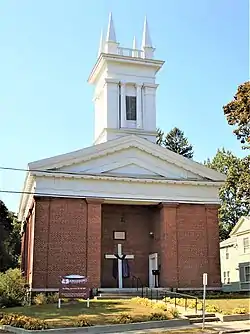 The Kingsboro Assembly of God Church, built in 1838 as a Presbyterian church, is the centerpiece of the Kingsboro Historic District
The Kingsboro Assembly of God Church, built in 1838 as a Presbyterian church, is the centerpiece of the Kingsboro Historic District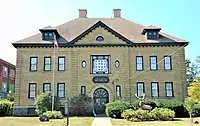 The Fulton County Historical Society operates the Fulton County Museum from a former public elementary school built in 1900
The Fulton County Historical Society operates the Fulton County Museum from a former public elementary school built in 1900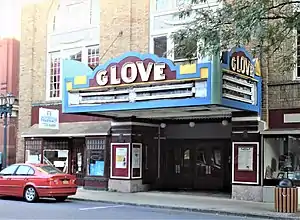 The Glove Theatre on North Main Street was the flagship of the Schine Enterprises chain
The Glove Theatre on North Main Street was the flagship of the Schine Enterprises chain The Gloversville Armory was built in 1904. It is still used by the New York Army National Guard.
The Gloversville Armory was built in 1904. It is still used by the New York Army National Guard. The Eccentric Club building, completed in 1908, is part of the Downtown Gloversville Historic District The club was founded in 1882.
The Eccentric Club building, completed in 1908, is part of the Downtown Gloversville Historic District The club was founded in 1882.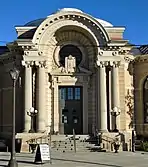 The Gloversville Public Library building is a Carnegie Library built in 1904
The Gloversville Public Library building is a Carnegie Library built in 1904
References
Notes
- "Charter and Code of City of Gloversville". General Code. Retrieved August 9, 2010.
- "Community – Demographic/Historical". City of Gloversville. Archived from the original on December 21, 2010. Retrieved August 9, 2010.
- "Members of the Common Council". City of Gloversville. Archived from the original on December 21, 2010. Retrieved August 9, 2010.
- "2019 U.S. Gazetteer Files". United States Census Bureau. Retrieved July 27, 2020.
- "Population and Housing Unit Estimates". United States Census Bureau. May 24, 2020. Retrieved May 27, 2020.
- "Johnstown Glove & Leather Directory (1910)". gloversandtanners.
- "Geographic Identifiers: 2010 Census Summary File 1 (G001), Gloversville city, New York". American FactFinder. U.S. Census Bureau. Archived from the original on February 13, 2020. Retrieved June 16, 2016.
- "U.S. Census Bureau QuickFacts: Gloversville city, New York in 2019". www.census.gov. Retrieved July 21, 2020.
- "Downtown Gloversville Historic District" Living Spaces
- "Kingsboro Historic District" Living Spaces
- Trebay, Guy (October 21, 2009). "Heir to a Glove Town's Legacy". The New York Times. Retrieved August 9, 2010.
- "Historic Gloversville". City of Gloversville. Archived from the original on January 13, 2016.
- Middleton. "Bullet cars on the FJ&G Railroad".
- "J. Myer Schine, 81, Hotel Magnate, Father of Figure in McCarthy Probe". Washington Post. May 10, 1971.
J. Myer Schine who started with a nickelodeon in Gloversville, New York and built a $150 million hotel, theater and broadcasting empire, died yesterday.
- Price, Debbie M. (February 22, 2017). "In Upstate New York, Leather's Long Shadow". Undark. Retrieved November 16, 2017.
- "Downtown Gloversville revitalization plan revealed | News, Sports, Jobs - Leader Herald". Retrieved July 21, 2020.
- "Gloversville mayor lays out revitalization plans | News, Sports, Jobs - Leader Herald". Retrieved July 21, 2020.
- "Residential, commercial building proposed | News, Sports, Jobs - Leader Herald". Retrieved July 21, 2020.
- "CRG, city working together to market Gloversville digitally". The Leader Herald. Retrieved July 21, 2020.
- "The Weather Channel – Monthly Weather for Gloversville, NY". Weather.com. Retrieved February 27, 2012.
- "Census of Population and Housing". Census.gov. Retrieved June 4, 2015.
- "Gloversville, New York 2018 Housing and Demographic Estimates". data.census.gov. Retrieved July 21, 2020.
- "Median Age of the United States in 2019". www.arcgis.com. Retrieved July 21, 2020.
- "Profile of General Population and Housing Characteristics: 2010 Demographic Profile Data (DP-1), Gloversville city, New York". American FactFinder. U.S. Census Bureau. Archived from the original on February 13, 2020. Retrieved June 16, 2016.
- "Selected Economic Characteristics: 2010-2014 American Community Survey 5-Year Estimates (DP03), Gloversville city, New York". American FactFinder. U.S. Census Bureau. Archived from the original on February 13, 2020. Retrieved June 16, 2016.
- "Religion in Gloversville, New York". Sperling's BestPlaces.
- "Gloversville has highest poverty rate in state, Hudson has the lowest". www.bizjournals.com. Retrieved July 21, 2020.
- "20 most dangerous places in Upstate New York, according to latest FBI crime data". newyorkupstate. July 7, 2017. Retrieved July 21, 2020.
- Fulton County Map Viewer (Map). Fulton County, NY. Archived from the original on July 15, 2010. Retrieved August 9, 2010.
- Overview of Gloversville showing locations of GESD schools (Map). Cartography by My Topo.com. Acme Mapper 2.0. Retrieved August 9, 2010.
- Phillips, Elizabeth. "Gloversville Enlarged School District – Gloversville, NY". Gloversville Enlarged School District, Capital Region BOCES Communications Service. Retrieved August 9, 2010.
- Berg (1989)
- Dobryznski, Judith H. (July 17, 1997). "Eugene Goossen, 76, Art Critic". The New York Times. Retrieved August 9, 2010.
Bibliography
- Berg, A. Scott (1989) Goldwyn: A Biography, New York: Knopf ISBN 9780394510590
- Decker, Randy L. (1998) The Fonda, Johnstown, and Gloversville Railroad: The Sacandaga Route to the Adirondacks. Charleston, South Carolina: Arcadia Publishing. ISBN 9780738556697
- Engel, Herbert M. (1991) Shtetl in the Adirondacks: The Story of Gloversville and Its Jews. Fleischmanns, New York: Purple Mountain Press. ISBN 9780935796223
- Larner, Paul (2009) Our Railroad: History of the Fonda, Johnstown, and Gloversville Railroad 1867–1893. Bloomington, Indiana: AuthorHouse. ISBN 9781438947631
- Middleton, William D. (2000) [1961] The Interurban Era. Milwaukee, Wisconsin: Kalmbach Publishing. ISBN 978-0-89024-003-8
